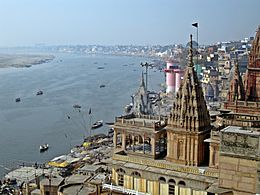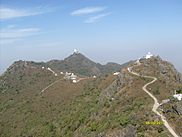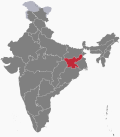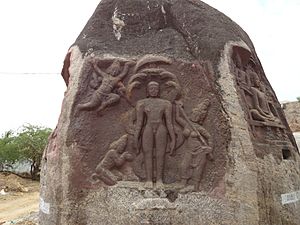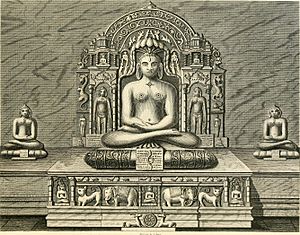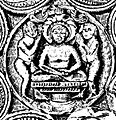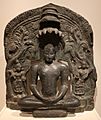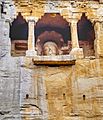Parshvanatha facts for kids
Quick facts for kids Parshvanatha |
|
|---|---|
| 23rd Jain Tirthankara | |
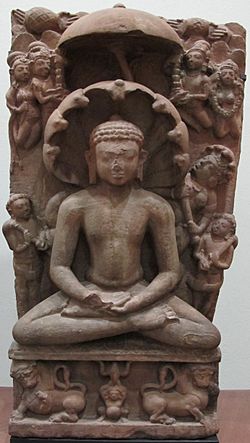
Image of Tirthankara Parshvanatha (Victoria and Albert Museum, 6th–7th century)
|
|
| Other names | Parshva, Paras |
| Venerated in | Jainism |
| Predecessor | Neminatha |
| Successor | Mahavira |
| Symbol | Snake |
| Height | 9 cubits (13.5 feet) |
| Age | 100 years |
| Tree | Ashok |
| Color | Green |
| Personal information | |
| Born | c. 872 BCE Varanasi |
| Died | c. 772 BCE Shikharji |
| Parents |
|
Parshvanatha, also known as Parshva or Parasnath, was a very important leader in Jainism. He was the 23rd of 24 Tirthankaras. A Tirthankara is like a supreme teacher who shows the path to spiritual freedom. People call him Kalīkālkalpataru, which means he is like a special wish-granting tree for our current age.
Parshvanatha is one of the earliest Tirthankaras that historians believe was a real person. He taught about Karma (the idea that your actions have consequences) a long time ago. Jain texts say he lived between 900 and 800 BCE. Historians think he lived a bit later, around 800 or 700 BCE.
He was born 273 years before Mahavira, another very famous Jain Tirthankara. Parshvanatha is seen as someone who helped spread and bring back Jainism. He achieved moksha (spiritual liberation) on Mount Sammeda in Jharkhand, India. This mountain is a very important place for Jains to visit. You can often recognize him by the snake hood over his head. People who worship him also often include Dharanendra and Padmavati, who are Jain snake gods.
Parshvanatha was born in Varanasi, India. He gave up his worldly life to start a group of monks. The two main Jain groups, the Digambaras and Śvētāmbaras, have different ideas about what Parshvanatha and Mahavira taught. This is one reason for their differences. Digambaras believe their teachings were the same.
However, Śvētāmbaras say that Mahavira added to Parshvanatha's teachings. Mahavira focused more on ahimsa (non-violence) and added a fifth rule for monks: celibacy (not marrying or having relationships). Parshvanatha did not require celibacy and allowed monks to wear simple clothes. Some Śvētāmbara texts even say Mahavira's parents followed Parshvanatha's teachings. This shows Mahavira built on ideas that were already there.
Contents
Was Parshvanatha a Real Person?
Parshvanatha is the earliest Jain Tirthankara that most people agree was a real historical figure. Old Jain writings give clues that he lived in ancient India. Historians also believe he was real because his "Four Vows" are mentioned in old Buddhist texts. For example, the Buddha's uncle, Vappa, was a follower of Parshvanatha's traditions.
Even though he is seen as historical, some details about his life are debated. For instance, how closely connected he was to Mahavira is not fully clear.
Jain texts say Parshvanatha lived for 100 years and came 273 years before Mahavira. If Mahavira lived around 599-527 BCE, then Parshvanatha would have lived around 872-772 BCE. Historians outside of Jainism often place Mahavira around the same time as the Buddha (5th century BCE). Based on the 273-year gap, they would place Parshvanatha in the 8th or 7th century BCE.
Some of the oldest Jain texts mention Mahavira and other ancient teachers, but they don't always name Parshvanatha specifically. Stories about Parshvanatha appear more in later Jain texts, like the Kalpa Sūtra. Early statues found don't always have the snake or lion symbols that later became common for Tirthankaras.
However, some very old bronze statues of Parshvanatha exist from the 2nd century BCE to the 1st century CE. An ancient tablet from the 1st century BCE also shows his image. A statue from the 7th century CE was found in Haryana, India.
Parshvanatha's Life Story
Parshvanatha was the 23rd of the 24 Tirthankaras in the Jain religion.
His Early Life
He was born in the city of Varanasi (also called Benaras) in India. His father was King Ashwasena, and his mother was Queen Vamadevi. Jain texts say that before he was born, he was a god named Indra in the 13th heaven. When he was in his mother's womb, gods celebrated. His mother had 16 special dreams, which in Jain tradition means a Tirthankara is about to be born. When he was born, the gods came down to celebrate his birth.
Parshvanatha was born with dark blue skin. He was a strong and handsome boy who played with nature gods. At age eight, he started practicing the basic duties of a Jain householder. He lived as a prince and soldier in Varanasi.
The Digambara Jain group says Parshvanatha never married. But Śvētāmbara texts say he married Princess Prabhavati. One Jain text says that at 16, Parshvanatha refused to marry. He chose to meditate instead, believing that "the soul is its only friend."
Becoming a Monk
At 30 years old, Parshvanatha decided to leave his worldly life and become a monk. He took off his clothes, cut his hair, and began strict fasting. He meditated for 84 days. Then, under a dhaataki tree near Benaras, he gained omniscience (perfect knowledge). During his meditation, he practiced very strict rules. He moved carefully, spoke thoughtfully, controlled his desires, and disciplined his mind and body. These practices are important in Jainism to let go of one's ego. Jain texts say that lions and fawns played peacefully around him while he meditated.
It is believed that Parshvanatha gained perfect knowledge at a place called Ahichchhatra. A story says that a demon named Kamath tried to stop him by causing a huge rainstorm. Parshvanatha was covered in water up to his neck. To protect him, the serpent god Dharanendra made a canopy of a thousand snake hoods over his head. The goddess Padmavati coiled herself around his body. Temples in Ahichchhatra are built to remember this event. After gaining omniscience, heavenly beings built him a special hall called a samavasarana where he could share his knowledge.
After teaching for 70 years, Parshvanatha achieved moksha (freedom from rebirth) at Shikharji on Parasnath hill. He was 100 years old. Jains celebrate this day as Moksha Saptami. On this day, people offer sweets and recite prayers at the mountain. Jains call Parshvanatha purisādāṇīya, meaning "beloved of the people."
His Past Lives
Jain stories tell about Parshvanatha's past lives as humans and animals. These stories show how his soul grew towards inner peace. Here are some of his past lives:
- Marubhuti: In one life, he was Marubhuti, the younger son of a prime minister. His older brother, Kamath, became an ascetic with dark powers and later killed Marubhuti.
- Vajraghosha (Thunder): Because of the anger he felt when he died, Marubhuti was reborn as an elephant named Vajraghosha. Kamath was reborn as a serpent. A wise king, who was once Marubhuti's father, taught the elephant to give up bad actions. When the serpent Kamath bit Vajraghosha, the elephant died peacefully.
- Sasiprabha: Vajraghosha was reborn as Sashiprabha, a god in the twelfth heaven. Even with many pleasures, he continued his spiritual journey.
- Agnivega: Sashiprabha was reborn as Prince Agnivega. As king, he met a sage who taught him about life's temporary nature. Agnivega became an ascetic and meditated in the Himalayas. A snake (the reborn Kamath) bit him, but he remained calm and accepted death.
Agnivega was reborn as a god. The soul of Marubhuti, Vajraghosha, Sasiprabha, and Agnivega was finally reborn as Parshvanatha. In one of these lives, he saved snakes from harm. Because of this, the serpent god Dharanendra and goddess Padmavati protected him. This is why they are often shown with Parshvanatha.
His Followers
According to a Śvētāmbara text called the Kalpa Sūtra, Parshvanatha had many followers. He had 164,000 male lay followers and 327,000 female lay followers. He also had 16,000 monks and 38,000 nuns. He had eight main monks called ganadharas. After his death, these monks continued his teachings.
The Digambara tradition says he had 10 main monks. Parshvanatha's monastic tradition was very important in ancient India. Even Mahavira's parents were lay followers who supported his monks.
Parshvanatha's Teachings
The two main Jain groups, Digambara and Śvētāmbara, have different ideas about Parshvanatha's and Mahavira's teachings. These differences are a big part of their disagreements. Digambaras believe there was no difference between what Parshvanatha and Mahavira taught.
However, Śvētāmbaras believe Mahavira added to Parshvanatha's teachings. They say Mahavira emphasized ahimsa (non-violence) more and added a fifth rule for monks: celibacy. Parshvanatha did not require celibacy and allowed monks to wear simple outer clothes. Śvētāmbara texts say Mahavira's parents followed Parshvanatha's teachings. This suggests Mahavira was a reformer who built on existing Jain ideas.
According to the Śvētāmbara tradition, Parshvanatha's monks followed four main rules. Mahavira later made these into five great vows for his monks. This difference has been discussed in Śvētāmbara texts.
An old Śvētāmbara text, the Uttardhyayana Sutra, describes a discussion between a follower of Parshvanatha and a follower of Mahavira. They talk about which teaching is true: the four rules or the five vows. Mahavira's follower says the differences are because people's abilities to understand have changed over time.
Some scholars say that Parshvanatha allowed monks to wear clothes.
According to Śvētāmbara texts, Parshvanatha's four rules were:
- ahimsa (non-violence)
- aparigraha (non-possession)
- asteya (non-stealing)
- satya (non-lying)
Ancient Buddhist texts that mention Jain ideas often talk about these four rules, not five. This has led some scholars to think that when Mahavira and the Buddha met, Buddhists only knew about the four rules from Parshvanatha's tradition. However, some early Jain writings connect Mahavira with three rules: non-violence, non-lying, and non-possession.
The Digambaras do not agree with the idea of "less than five vows" from Śvētāmbara texts. They believe there was no difference in the teachings. Some Digambara scholars say that the "fourfold" rules actually meant "four ways" of living, which Mahavira then put into five vows.
Writings About Parshvanatha
The Kalpa Sūtra contains life stories of Tirthankaras like Parshvanatha and Mahavira. The Uvasagharam Stotra is a prayer written for Parshvanatha. The Mahapurāṇa also includes stories about Parshvanatha. Parshvabhyudaya tells the story of Parshvanatha's life. Many other hymns and poems praise Parshvanatha and tell stories from his past lives.
Even Guru Gobind Singh, a Sikh guru, wrote a biography of Parshvanatha in the 17th century.
How Parshvanatha is Shown (Iconography)
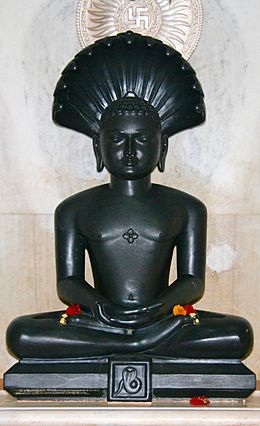
Parshvanatha is a very popular Tirthankara to worship. People believe he can remove problems and help his followers. In the Shvetambara tradition, there are 108 famous statues of Parshvanatha, often named after the place they are found, like Shankheshwar Parshvanath.
Parshvanatha is usually shown sitting in a lotus pose or standing in a kayotsarga (meditative) posture. Statues and paintings show his head protected by a multi-headed serpent, spread out like an umbrella. A snake symbol is carved or stamped below his legs to identify him. He is often shown with Dharnendra and Padmavati, the Jain snake god and goddess.
Other Tirthankaras also have serpent hoods, but Parshvanatha's usually has seven or more heads. Statues of Parshvanatha with seven snakes over his head have been found from the 1st century BCE.
Old statues and carvings of Parshvanatha sometimes include scenes and other figures called yakshas. Digambara and Śvētāmbara art shows him differently. Śvētāmbara art shows him with a serpent hood and a yaksha that looks like Ganesha. Digambara art shows him with a serpent hood and Dhranendra. Some scholars say that showing Hindu gods like Ganesha as yakshas serving Parshvanatha puts them in a lower position.
An ancient tablet from around 15 CE, found at Kankali Tila, is dedicated to Parshvanatha. It shows him sitting in a meditation pose with crossed ankles, a seven-headed snake hood above his head, and a special mark called a shrivatsa on his chest.
-
Uttar Pradesh, 2nd century (Museum of Oriental Art)
-
5th century (Satna, Madhya Pradesh)
-
6th century, Uttar Pradesh
-
7th-century Akota Bronze (Honolulu Museum of Art)
-
9th century - Cleveland Museum of Art
-
10th-century copper, inlaid with silver and gemstones (LACMA)
-
Karnataka, 12th century (Art Institute of Chicago)
Huge Statues of Parshvanatha
There are many very large statues of Parshvanatha:
- The Navagraha Jain Temple has the tallest statue of Parshvanatha. It is 61 feet (18.6 meters) tall and stands on a 48-foot (14.6-meter) base. This statue weighs about 185 tons.
- The Gopachal rock cut Jain monuments were built between 1398 and 1536. The largest statue of Parshvanatha sitting cross-legged is 47 feet tall and 30 feet wide.
- An 11th-century temple called Parshvanatha basadi in Shravanabelagola has an 18-foot (5.5-meter) tall standing statue of Parshvanatha.
- The Parshvanatha basadi, Halebidu, built in 1133 CE, has an 18-foot (5.5-meter) tall black granite statue of Parshvanatha.
- A 31-foot (9.4-meter) tall standing statue was put in place at the Vahelna Jain Temple in 2011.
- The city of Vadodara has approved plans to build a 100-foot tall statue in a pond there.
Temples Dedicated to Parshvanatha
Parshvanatha is one of the five most important Tirthankaras that Jains worship. Many Jain temples across India are dedicated to him. These temples are important pilgrimage sites. Mount Parasnath in Jharkhand is a very special place. It is believed that 20 out of 24 Tirthankaras, including Parshvanatha, achieved nirvana (spiritual liberation) there.
Shankheshwar Parshvanath in northern Gujarat is considered a very holy place for Śvētāmbara Jains. Replicas of Parshvanath temples are popular among Śvētāmbara Jains. For example, the Godiji temple in Sindh has a replica in Mumbai. Jains believe that worshipping these replica idols allows them to worship the original idol directly. People pray to Parshvanatha for various wishes. He is also known as Chintamani, meaning "wish-fulfilling gem."
Important Parshvanatha temple complexes include: Shikharji (Sammet Sikhar) in Jharkhand, Mirpur Jain Temple, Kanakagiri Jain tirth, Panchasara Jain temple, Humcha Jain temples, Ahi Kshetra, Kallil Temple, Mel Sithamur Jain Math, Pateriaji, Nainagiri, Kundadri, Bijoliaji, Jirawala, Gajpanth, Andeshwar Parshwanath, Bada Gaon, Akkana Basadi, and Guru Basadi.
-
Parshvanatha temple, Khajuraho, a UNESCO World Heritage Site
-
Parshavanth temple, Jaisalmer Fort, a UNESCO World Heritage Site
-
Antwerp Jain Temple, Belgium
-
Samovsaran Mandir, Palitana
-
Parshwanath at Jirawala, Rajasthan
See also
 In Spanish: Parsuá para niños
In Spanish: Parsuá para niños
- Naminath


